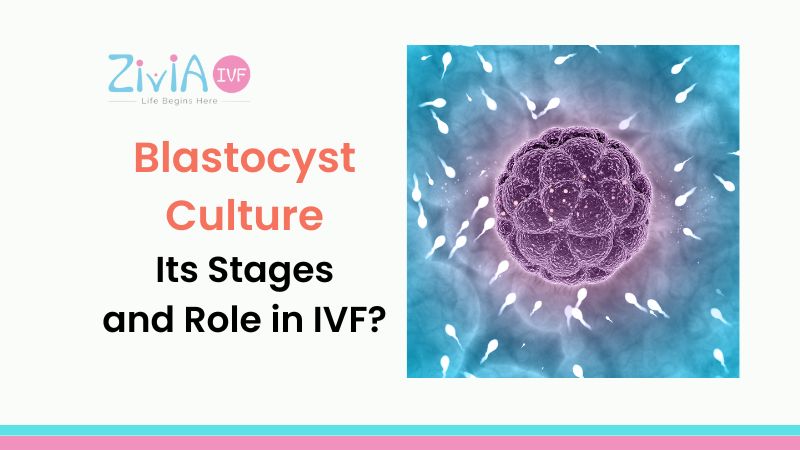
What is blastocyst culture?
Simply put, blastocyst culture is a process where a blastocyst – an embryo that is 5 to 6 days old – is developed outside the human body in a lab using specialized culture media. This is done by nurturing the embryo until it becomes ready for implantation into the inner lining of the uterus (called the Endometrium).
Normally, pregnancy occurs when the egg is released by the ovary and fertilized by the sperm in the fallopian tube, leading to the formation of an embryo. This embryo then travels through the fallopian tube to the uterus. Along the way, the two-celled embryo develops into a blastocyst. When the fertilization and embryo development happens in a lab outside the body, it is called blastocyte culture.
A blastocyst consists of 100-200 cells that are arranged into two parts: the Trophectoderm, which is the outermost layer that plays a crucial role in implantation, and the Inner Cell Mass, which are the early cells of the fetus.
The blastocyst development is factored in the following stages
Stages of blastocyst development in blastocyst culture
Following the egg retrieval procedure in the IVF laboratory, fertilization is achieved either through in-vitro fertilization (IVF) or intra-cytoplasmic sperm injection (ICSI). The resulting embryos are then placed in an incubator to undergo further development.
The various stages of embryonic development in the laboratory are as follows:
- Day 0: The day of egg retrieval
- Day 1: The pronuclear stage, where the embryologist checks to see how many eggs have successfully fertilized
- Day 2: The two to four-cell stage
- Day 3: The eight-cell stage
- Day 4: The morula stage
- Day 5 or 6: The blastocyst stage.
Blastocyst culture procedure:
The steps involved in blastocyst culture can be divided into four main steps, namely:
Fertilization of eggs with sperm using IVF or ICSI:
The process of fertilization in IVF involves the mixing of eggs and sperm in a petri dish. It may also demand ICSI, a more precise ART method that directly injects a selected and healthy sperm into the egg. This step is typically carried out on the same day as the egg retrieval procedure.
Incubation of resulting embryos in a specialized culture media:
The fertilized eggs or embryos are placed in a specialized culture media that provides all the necessary nutrients required for the embryo to grow. Next, the embryos are then placed in an incubator that mimics the conditions of the human body to support their growth.
Observation and monitoring of embryo growth to the blastocyst stage:
Embryologists monitor the growth of embryos to track their growth progress. They check the embryos regularly under a microscope to assess their quality and to make sure they are growing at the expected rate. By day 5 or 6, some of the embryos may have developed into blastocysts.
Selection and transfer of the healthiest blastocysts into the uterus:
The best quality blastocysts are selected for transfer into the uterus. This involves carefully removing the blastocysts from the culture media and placing them into a thin catheter. The catheter is then inserted into the uterus, where the blastocysts are released. The process is typically done with ultrasound guidance and does not require anesthesia.
Role of blastocyst culture in IVF/ Benefits of blastocyst culture
Blastocyst culture is an important part of the IVF process. Blastocyst culture benefits those who opt for IVF for reproducing. It plays a crucial role in the success of IVF fertility treatments.
Blastocyst culture has several advantages over earlier stages of embryonic development in the IVF process. Some of the key advantages are:
- Increased chances of implantation: Blastocysts have a greater chance of implantation compared to earlier-stage embryos, ultimately leading to higher pregnancy rates.
- Reduced risk of multiple births: By selecting the most viable and healthy blastocysts for transfer, the risk of multiple births is reduced. This, in turn, reduces the risk of obstetric complications associated with multiple pregnancies.
- Increased opportunities for cryopreservation: As single embryo transfer is preferred nowadays, more embryos can be cryopreserved for future use in frozen embryo transfer (FET) cycles, increasing the chances of successful pregnancies.
Who can benefit from blastocyst culture?
Blastocyst culture can benefit:
- Patients with a history of multiple failed IVF, as it provides more information about embryo growth and can improve pregnancy rates.
- Those looking to eliminate the risk of multiple pregnancies, as it allows for the transfer of the single healthiest embryo.
Blastocyst culture is an important part of the IVF process that can increase the chances of a successful pregnancy by selecting the best quality embryos for transfer. Choose Zivia IVF to ensure better results, as we have 30+ years of experience and 73% success rates.
